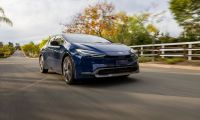The reason PHEV drivers don’t like the idea of burning gasoline for heat is that it feels wasteful. In the grand scheme of things, it probably is considering how much energy goes into producing the gasoline used for cabin heat in PHEVs like the Kia Sorento PHEV. The alternative (an electric resistance heater or heat pump) would be more energy intensive in the near term though considering the energy and resources, and likely additional battery capacity, used to manufacture the components solely responsible for providing electric heat are greater compared to the gasoline engine in a PHEV that is both for propelling the vehicle and for providing heat. But as long as your cold weather drives are more or less within the range of the battery in your PHEV (30-40 miles depending on how you drive and conditions for the Sorento PHEV), using the heat in your PHEV shouldn’t degrade your fuel efficiency nearly as much as when you are driving in Hybrid mode and using gas for propulsion. In my PHEV, I get anywhere between 50 mpg and often well over 150+ mpg (on the car’s display) when I am using gas strictly for heat, depending on how far I’m driving, and how cold it is. Of course as soon as I travel much further than about 40 miles, this changes and my fuel economy steadily drops until, after sufficient distance, it settles somewhere between the low 30’s to the mid 40’s in mpg. In case you’re wondering what that distance might be, it depends, but in winter I’d say it is another 30-60 miles.
My Kia Sorento PHEV, like any other PHEV, is designed to use gas sometimes. It is a requirement for keeping the engine in proper operating condition. As much as PHEV drivers might dislike this fact, or feel disappointed by it, it is the tradeoff we must accept for the flexibility, reassurance, and utility that having a gasoline engine can provide. It is worth remembering, and it is something I try to tell people who are either new to plug-in vehicles or who are interested in what they’re like, PHEVs will greatly reduce the amount of gas you use (if plugged in regularly and routinely), possibly by 90% or more (should you do about that much of your driving over distances that are within its all-electric range). But PHEVs will always need to use some gas, by design. Don’t let that deter you though, if your ambition is to get away from gasoline, or pollute less; PHEVs can get far better fuel efficiency than standard hybrids. In fact, if you are using the MPGe (or miles per gallon equivalent) ratings as a guide, some PHEVs are actually more efficient than EV’s.
What’s that you say, MPGe isn’t a fair comparison, or it’s because the EV weighs a lot more, etc. etc.? Well, those statements may or may not be true (but I tend to think they are truth-y), but compare the Rivian R1S all electric SUV at 69 MPGe to my Sorento PHEV at 79 MPGe as one example. This was one reason why I considered the Sorento PHEV in the first place, it was (potentially) about as energy thirsty as a much more expensive fully electric SUV. In my real world experience of driving the Sorento PHEV for a year plus though, so far I am a little bit under that 79MPGe figure, if I just go by the Kia’s display. The displays say I am a little over 68 MPGe so far, but I have used a tad over 100 gallons to drive over 8,600 miles, which means you could say I am getting about 86 mpg (though that ignores the electricity I used and isn’t a full measure of energy use as such). I have perhaps done a few more long distance drives in my first year of ownership though as I wanted to test my new Kia out on a variety of trips. Should I also start driving it for work commutes a little more often, which I can do without using gas, I am certain that the 79 MPGe rating is something I could achieve, depending.
At the end of the day, PHEVs are capable of delivering significant emissions reduction at a lower price point/lower use of materials while offering flexibility that EVs might lack, but only if those PHEVs are plugged in and driven in EV mode a majority of the time. This remains true even if/when the PHEVs must burn gasoline for cabin heat while they are within the range of their all electric mode and not using the gas engine for propulsion.
What do you think, readers? Are you thinking about getting a PHEV, or do you already own one? Have you had a different experience in winter driving efficiency? Please leave your comments and questions below.
Image courtesy of Justin Hart.
Justin Hart has owned and driven electric vehicles for over 15 years, including a first generation Nissan LEAF, second generation Chevy Volt, Tesla Model 3, an electric bicycle and most recently a Kia Sorento PHEV. He is also an avid SUP rider, poet, photographer and wine lover. He enjoys taking long EV and PHEV road trips to beautiful and serene places with the people he loves. Follow Justin on Twitter for daily KIA EV news coverage.













Comments
the Sorento phev is only 90hp
Permalink
the Sorento phev is only 90hp electric and Rivian R1S 800hp so it's like comparing a jeep trackhawk or Durango hellcat to a Ford EcoSport 1.0...
also RAV4 prime is 180hp electric and 94mpge, so Sorento phev is quite underwhelming
I think PHEV are good because they can do all daily driving on electric and be more practical than EV for long trips but they need to have decent emEV mode performance lire RAV4 prime. if you get a taste of EV you will never wanna go back to a "turtle" EV mode like some PHEVs...
also the cheapest used 3 row phev with decent mpg and not 100k+ miles is at least $40k
I got my Sorento V6 with 1 year/16k miles for 18k and it gets 30/32mpg highway despite 25mpg EPA rating, and I got a 30k miles fiat 500e for 8k. I have best of borh worlds, snappy EV acceleration with zero gas use for city driving, and comfortable hassle free long trips with mpg that is not too far off any hybrid SUV. I am waiting for a good public fast charging network to compete with Tesla before considering a long range EV
While I don’t disagree that
Permalink
In reply to the Sorento phev is only 90hp by geemy (not verified)
While I don’t disagree that the electric motor performance of the Sorento PHEV is underwhelming, that is specifically and appropriately because Kia is aiming for efficiency (and not power-performance) in this PHEV. Neither Toyota or Rivian are doing the same, as both are engineered more toward power-performance than efficiency-performance (not that I am saying either of those is inefficient). Consider it this way: the Rav 4 Prime has an additional 4.3 kWh of battery (which is essential for the Toyota to be able to supply the appropriate amount of energy to its more powerful electric motor, it wouldn’t be able to output as much power without the extra kWh). But this additional battery capacity only provides an additional 10 miles of estimated range. That’s actually kind of pathetic and means the Kia is more efficient than the Rav 4 in a crude sense; you’d have to look at how much of the battery is usable. Regardless, the Toyota uses more precious battery resources for I would say a “paltry” amount of additional range. It is wasteful, in my opinion, and though the Rav4 Prime is much more powerful, and the Rivian far more still, that snappy acceleration is extremely costly when you weigh what it costs (monetarily and environmentally). Don’t get me wrong, I also own a Tesla and very much enjoy the thrust a powerful electric motor can provide, but when your primary motivation is to use less fuel and resources, the Kia beats out both the Rav4 Prime and the Rivian. You might have to accept leisurely acceleration if you want to keep it in electric only mode, but if you require more thrust, I assure you the Sorento PHEV in hybrid mode, is as about as fast as most other non luxury/performance 3 row SUVs. Not saying it will win any drag races, but it does have more than adequate power when both power sources are engaged.
I own a Mercedes GLA 250 e…
Permalink
I own a Mercedes GLA 250 e since September 2021; I'm satisfied with the range I can cover in e mode, up to 40 miles, when temperature is about 70 °F and more but I was really disappointed while few days ago I realized that with external temperature of 45°F the battery was empty after driving 17 miles in a city like Milan.
Of course temperature and even more heating system plaied a role in that so I found very interesting your idea to use thermal engine to heat the car but it's not clear to me how I can do it with the avaiable menu of mode (sport, comfort, electrical, battery saving and economic). Any idea? Thanks.
We are thinking of getting a…
Permalink
We are thinking of getting a phev. Rav4 prime is not available in our state, but we think the hyundai tucson phev is. We have been reading as much as we can find on phevs and there seems to be a variety of opinions, particularly on the issue of what happens when you use heat in the cabin.
Any good advise?